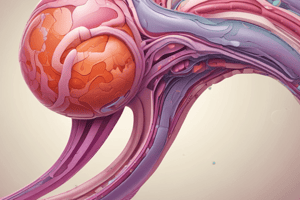Podcast
Questions and Answers
What is the function of the sebaceous glands in the mons pubis?
What is the function of the sebaceous glands in the mons pubis?
- Producing lubricating secretions
- Storing reproductive cells
- Regulating body temperature
- Releasing substances involved in sexual attraction (correct)
What is the primary function of the labia majora?
What is the primary function of the labia majora?
- Regulating body temperature
- Protecting the labia minora (correct)
- Storing reproductive cells
- Producing lubricating secretions
What is the clitoris sensitive to?
What is the clitoris sensitive to?
- Hormonal changes
- Physical pressure
- Sexual stimulation (correct)
- Emotional stimulation
What is the primary function of the urethra?
What is the primary function of the urethra?
What is the perineum?
What is the perineum?
What is the function of the vagina during childbirth?
What is the function of the vagina during childbirth?
What is the primary function of the fallopian tubes?
What is the primary function of the fallopian tubes?
What is the function of the ovaries?
What is the function of the ovaries?
What is the primary function of menstruation?
What is the primary function of menstruation?
What is the primary function of the uterine cervix?
What is the primary function of the uterine cervix?
Flashcards are hidden until you start studying
Study Notes
Functions of the Vagina
- The vagina has three main functions: sexual intercourse, childbirth, and menstruation
Uterus
- The uterus is a hollow muscular organ responsible for the development of the embryo and fetus during pregnancy
- It is divided into three parts: Fundus, Body, and Cervix
- The Cervix plays a vital role in controlling movement into and out of the uterus, protecting the fetus during pregnancy, and delivering the fetus during childbirth
- The uterus is composed of three distinct layers: Endometrium, Myometrium, and Perimetrium
Fallopian Tubes
- The Fallopian tubes are two long, fine tubes connecting the ovaries to the uterus
- The tubes are composed of the Fimbriae, Infundibulum, Ampulla, and Isthmus
- Fertilization usually takes place in the Fallopian tubes
Oogenesis
- Oogenesis is the process of producing female gametes in the ovaries
- Unlike males, females produce all oocytes during fetal development
- During fetal development, oogonium differentiate into primary oocytes, which remain in prophase I of mitosis
Follicle Development
- Primary follicles are produced during fetal development
- At puberty, secondary follicles develop, which eventually become Graafian follicles
- The Graafian follicle releases the secondary oocyte during ovulation, and the remaining follicle becomes the Corpus Luteum
The Journey of the Egg
- Ovulation occurs under the influence of FSH and LH, releasing a mature ovum
- The mature ovum is caught by the Fimbriae and directed down the Fallopian tube
- If sperm penetrate the ovum, it becomes a fertilized zygote
- After a two-week period of rapid cell division, the zygote forms a solid cluster of cells, which eventually turn into a hollow Blastocyst
Implantation
- Implantation occurs when the Blastocyst exchanges hormones with the endometrium and adheres to the wall
External Genitalia
- The external female genitalia (vulva) include the Mons pubis, Labia majora, Labia minora, Clitoris, Opening of the urethra, and Perineum
- The Mons pubis is a rounded, hair-covered area containing sebaceous glands involved in sexual attraction
- The Labia majora are large, fleshy folds of tissue that enclose and protect the other external genital organs
- The Labia minora are small folds of tissue that surround the openings to the vagina and urethra
- The Clitoris is a small, sensitive protrusion that can become erect and stimulate orgasm
- The Perineum is the area between the opening of the vagina and the anus, below the Labia majora
Studying That Suits You
Use AI to generate personalized quizzes and flashcards to suit your learning preferences.


